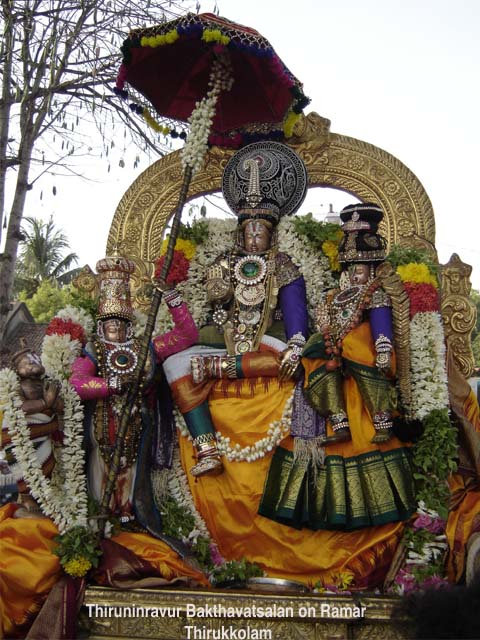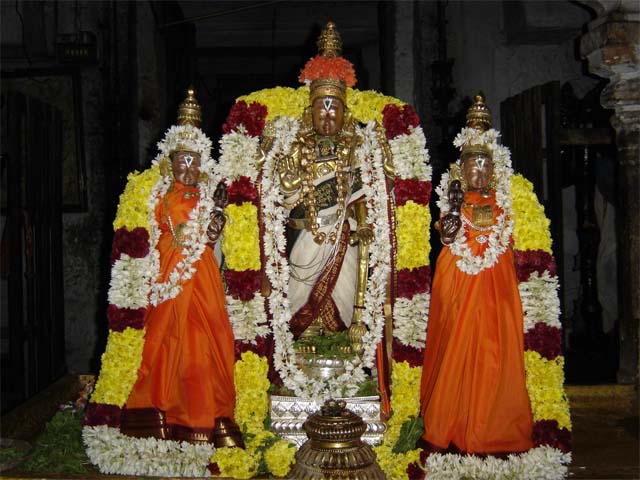Among the various works of Swami Ramanuja, Gadyatrayam [गद्यत्रयम] is very important. He has very clearly explained that we have to approach the Lord, through Sri Maha Lakshmi. In that he says that finding no other refuge, he was surrendering at Her feet, to surrender unto the Lord. Today's [1st January 2009] lecture is from the sannidhi of Sri Thayar in Sriperumbudur. As we come out of Swami Ramanuja's sannidhi and turn right to go round, we find, after a long mandapam, Sri Thayar's sannidhi. She is called Sri Yatirajanathavalli Thayar [ஸ்ரீ யதிராஜநாதவல்லி தாயார் ]. She is seated as Sri Gajalakshmi, with one hand showing abhaya and the other pointing to Her divine feet for all of us to prostrate and get redeemed. She assures us that She would recommend to the Lord to rescue us and not to consider our sins. With Her blessings we will go through the literary works of Swami Ramanuja. Swami Ramanuja is a great philosopher and was born in Sriperumbudur. To study under Swami Yadavaprakasa, he went to Thirupputkuzhi and Kanchipuram. We had visited these Two Kshetrams earlier. He learnt all subjects and with the blessings of Swami Alavandar, he obtained necessary skills. To make people to understand Vedas properly, Swami Ramanuja wrote Nine literary works. These are called Navaratna [Nine gems]. We should necessarily remember these works. All the works are in Sanskrit. But we can find now all in Tamil scripts and with Tamil translations. Swami Ramanuja regarded Swami Alavandar as his Acharya. But he could not study directly under Swami Alavandar. We had seen earlier that when Swami Ramanuja came to Srirangam to learn under Swami Alavandar, the latter had died. With disappointment that he could not learn under Swami Alavandar, Swami Ramanuja returned to Kanchipuram. To satisfy the desire of Swami Alavandar, Swami Ramanuja wrote Sri Bhashyam, a very important commentary on Brahma sootram [ब्रह्म सूत्रं] of Veda Vyasa. Braham sootram is collection of aphorisms on the essence of Vedanta [Upanishads]. These contained very few words but were containing ocean of interpretations. The First sootram is 'athato brahma jingyasa' [अथातो ब्रह्म जिज्ञास]. Each sootram had to be elaborately commented upon. Were they not commented by others earlier? Was Swami Ramanuja needed to interpret afresh? Swami Ramanuja never commented anything new. He explained in detail whatever was alraedy told in Vedanta. In Dwapara yug, Vyasa had composed Brahma sootram. Many sages like Tranka, Dramida, Bhodayana, etc., had already made available good commentaries. But there was no detailed commentary available. To compensate this deficiency, Swami Ramanuja wrote Sri Bhashyam. In the invocation Mangala sloka for Sri Bhashyam, Swami Ramanuja states that the true meanings of Vedanta were wrongly interpreted by many in their own way. Swami Ramanuja tried to expose the correct interpretation to the World, in a simple manner. He further states that Bodhayana and others had done enough, but unfortunately, in the grip of short sighted persons, its significance was lost. Swami Ramanuja attempted to restore its glory. In that process he simplified the interpretation. All mean philosophies, which never accepted the supremacy of Vedas, had to be condemned logically and establish philosophy based on Vedas. Some had accepted Vedas but gave wrong interpretations; and, they were also refuted. Thus Swami Ramanuja re-established Visishtadvaita as the correct philosophy based on Vedas. His commentary was acclaimed by Sri Sharada Devi [Sri Saraswati Devi] and gave it the name Sri Bhashyam. She praised it as the correct interpreation as envisaged by Veda Vyasa. In fact, we are having these lectures on Bhagavad Gita, based on Gita Bhashyam, another literary work of Swami Ramanuja. The Nine works of Swami Ramanuja are:
- Sri Bhashyam,
- Vedanta saram,
- Vedanta deepam,
- Gita Bhashyam,
- Saranagati gatyam,
- Sriranga gatyam,
- Vaikunta gatyam,
- Nityam [daily rituals we have to follow] and
- Vedarta sangraham.
samah satrau ca mitre ca
tatha manapamanayoh
sitosna-sukha-duhkhesu
samah sanga-vivarjitah
"One who is equal to friends and enemies, who is equipoised in honor and dishonor, heat and cold, happiness and distress, fame and infamy"
Sangha = attachment, vivarjita = cut-off, that is without any attachment or totally detached from [பற்று]. Sri Krishna tells Arjuna that His devotee is detached from all, excepting in Him. How is he? Sama = [he regards as] equal,
- satrau = enemies, ca mitre = and friends. He is not showing too much affection to a friend nor shows hatered for enemies. He treats both equal.
- mana = honour, apamana = dishonour. He behaves in the same way whether he is honoured or chided.
- sita = cold, usna = heat. He regards both heat and cold with the same feeling.
- sukha = comforts and happiness, dukhe = discomforts and distress. Both are inevitable in everyones life, but to be regarded in stride.










